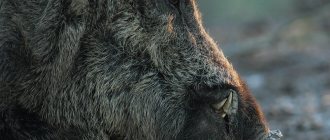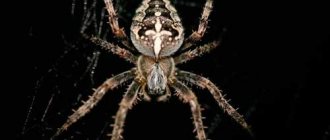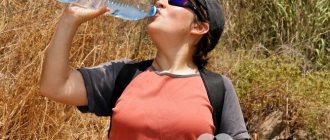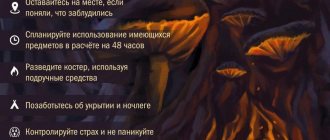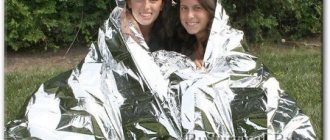When going into the forest to pick mushrooms, or going on a long hike with tents, remember that, first of all, you are going to someone else’s house, the inhabitants of which are wild animals. It could be a harmless squirrel, a peace-loving elk, or a female bear with cubs, who, upon seeing a person, will certainly decide that you pose a threat to her.
Most cases of human bites by wild animals are caused by people themselves. We get too close to them, we are curious, we want to photograph, touch, feed, we neglect safety measures when communicating with animals.
Quite recently, a video from the Arkhangelsk region appeared on the Internet. Five builders were filming the cubs and having fun. A minute later, an angry bear came out of the forest and rushed at the people. Three construction workers died on the spot.
Another case of a bear attack occurred with a reindeer herder. He was taken to hospital in critical condition. He himself names the reason for the attack - he ran, which provoked the aggression. Recently, cases of wolves appearing near large cities, and in places where they are not accustomed, have become more frequent. So, in October last year, residents of Crimea observed packs of wolves in the vicinity of Simferopol. It is known that wolves have never lived in Crimea. Most likely, they crossed the frozen Sea of Azov in winter from the Rostov region in search of food. In the spring of this year, in several villages of Crimea, a “mad” wolf began to appear in courtyards and rush at animals and people. At the same time, experts note that wolves rarely attack groups of people, mainly individuals. In the Kirov region, a case was recently recorded of a wolf attack on a young girl who decided to cross a field alone in the evening. Unfortunately, the incident ended tragically.
Going to the forest
If you follow safety rules and are careful and observant, meeting forest dwellers can be quite safe. When going into the forest, you need to take the necessary standard kit: a folding knife, a charged phone, matches, a bottle of water, pepper spray. It is better to go into the forest in a group of two or three people. If you are going to stay in the forest overnight, then be sure to decide who will be on duty and make sure that the fire does not go out. As a rule, at night any wild animal will be afraid of fire and will not come close to the campsite. Along the perimeter of the tent city, you can mark the territory with your own urine or string a rope with something that jingles, for example, tie bottles or cans. To avoid attracting animals with odors, it is better to put leftover food in a tight bag. Let's look in more detail at which forest animals most residents of our country can encounter, and how to behave so that the animals do not show aggression.
Bear
Bears are extremely rare in the forests of the European part of our country due to their extermination. The largest populations live in the Leningrad and Novgorod regions, Bashkiria, Siberia, and the Far East. As a rule, they do not hunt humans, unlike wolves. In summer, bears are mainly provided with plant and animal food, so they do not pose a danger to humans. The exception is the period from May to June - the time of active breeding of bears. In winter, these animals hibernate for 3-6 months.
Bear attacks on people usually happen for two reasons. 1. The first one is if you accidentally woke up a bear after hibernation. During this period, he will be especially hungry and aggressive. 2. The second possible reason for a bear attack is a meeting between a mother bear and her cubs on your way. Therefore, the best way to protect yourself from a bear is to try not to encounter it.
How else can you protect your site from attacks by forest animals?
As we noted above, forest nets are effective for protecting against single and small animals. If your site is attracted by large individuals: wild boars, and God forbid, wolves, then it is already necessary to solve the problem by installing more serious fences.
One of the most effective and universal solutions is the installation of a metal mesh. Mesh fences are inexpensive, easy to install and have high strength and durability.
Let us consider below what types of metal fence mesh there are and how they differ from each other.
How to choose a metal entrance door?
Sealing paste. How to choose the right one for pipes in the house?
Top 30 best villages in the suburbs of Moscow. We choose a house, cottage, townhouse up to 10 km from the Moscow Ring Road
How to make a coating waterproofing of the floor in a house before screeding?
How to build a change house yourself and convert it into a country house?
Timber for building a house. How to choose and what to pay attention to?
Where to buy a winter house, a dacha in the Moscow region and the Moscow region?
Is it possible to register in SNT? How to get a registration?
Modern bathroom design in cottages
Multi-format villages. What it is? Interview
How to prevent meeting a bear in the forest?
It is important to be cautious and careful in the forest, especially if the forest is in the habitat of bears. It is better to avoid a dense overgrown forest, as it reduces the likelihood of seeing an animal from afar and having time to get away from it. Most often, encounters with bears occur in places where there are a lot of berries, or along the banks of the river. As a rule, in places where food is collected, bears do not behave aggressively, but, on the contrary, when they smell or hear a person, they will move away from him. Therefore, in order to avoid meeting a bear, be loud, talk, step on cracking branches, sing in the forest, whistle. Particular attention should be paid to bear trails. If you see a bear's footprint in the snow in the spring, this may be evidence of its awakening from hibernation. You need to go around this place and go in the direction opposite to the direction the animal is moving.
Proper disposal of garbage, especially food waste, is also the key to safe coexistence between humans and bears. By creating spontaneous landfills in the forest, directly next to a village or in the fields, we thereby attract wild animals closer to humans and create a lack of fear in them. Bears should not form associations between food and humans. For the same reason, if you stay overnight in the forest, try to hide the leftover food as best as possible, put it in a tent, and wrap it in several bags.
If you unexpectedly meet a bear
If you notice a bear in the forest near you, you need to move away to a safe distance as quietly as possible without panic. If the bear notices you, but does not run, you need to try to drive him away by shouting or shooting into the air. False flares and a flare gun, which are sold in fishing stores, are suitable as deterrents. You can also spray pepper spray so that its pungent smell will scare away the bear, or set fire to the clothes you take off. Don't quickly run away from a bear. It is necessary to slowly, turning to face him, move away. You can only run when you are so far away that the bear disappears from your field of vision. There are situations in which you can see a bear cub in the forest. You should not try to touch it or take a photo, as the bear is most likely somewhere nearby.
If the bear is at a distance of 5-7 meters from you, then most likely this will be followed by an attack. It is important to note that before an attack, a bear may not show any outward signs of aggression. The video above is evidence of this. Conversely, if a bear stands on its hind legs, this may not mean that it wants to attack. Therefore, admiring bears in the forest leads to tragic consequences.
Cohesion
(from Latin
cohaesus
- connected, linked), the cohesion of molecules (atoms, ions) of a physical body under the influence of attractive forces. These are the forces of intermolecular interaction, hydrogen bonding and (or) chemical bonding. They determine the totality of physical and physicochemical properties of a substance: state of aggregation, volatility, solubility, mechanical properties, etc.
The intensity of intermolecular and interatomic interaction (and, consequently, the force of cohesion) decreases sharply with distance. Cohesion is strongest in solids and liquids, i.e. in condensed phases, where the distance between molecules (atoms, ions) is small - on the order of several atoms.
In gases, the average distances between molecules are large compared to their sizes, and therefore cohesion in them is negligible.
Work of cohesion
is the free energy of dividing a body into parts and removing them to such a distance that the integrity of the body is violated. The work of cohesion Wc is defined as the work of reversible isothermal destruction of a body: Wc=2γ, where γ is the specific surface energy (for solids) or surface tension (for liquids).
The relationship between Wc and the work of adhesion Wa, which characterizes the adhesion of dissimilar bodies (adhesion), serves to determine the ability of liquids to wet solids: with Wa<½Wc there is non-wetting, with ½Wcac there is wetting, with Wa>Wc the liquid spreads over the surface of the solid. cohesive energy density is also widely used
Eс, which is identified with the internal energy of evaporation (or sublimation) Uexp, related to the molar volume of the substance Vt: Fc=Uexp/Vm. Using the Ec values, one can calculate the Hildebrand solubility parameter: Ec=σ2 (solubility).
For low-molecular compounds, cohesion energy is considered as an excess of the potential energy of the liquid over the potential energy of the vapor, numerically equal to the internal energy of evaporation E at pressure p and temperature T:
E=−ΔUsp=p(Vg−Vl)−ΔHsp, (1)
where ΔHsp is the enthalpy of evaporation, the indices “g” and “g” mean the gaseous and liquid states of the substance, respectively.
When Vg>>Vl and under conditions when steam behaves like an ideal gas, the following relation is valid:
E=RT−ΔHsp, (2)
where R is the gas constant.
The values of E and Ec are determined experimentally using calorimetry data; The empirical Hildebrand relation is also used: ΔHsp = 0.02 T2ksp + 27.3 Tbp − 2950. Approximate calculations of Ec are based on the assumption of the additivity of contributions to the cohesion energy density of the energies of chemical bonds connecting atoms (incrementals) ΔEi: the cohesion of low-molecular substances is associated with their state of aggregation Ec=∑iΔEi, and serves to assess the properties (thermodynamic, mechanical, etc.) .
The cohesive characteristics of low molecular weight liquids and solids are sensitive to their chemical nature. Thus, the introduction of halogen atoms into hydrocarbon molecules leads to an increase in Ec from 8-25 to 10-44 kJ/mol, nitrogen - up to 14-42 kJ/mol, sulfur - up to 12-52 kJ/mol.
With the introduction of hydroxyl, carbonyl and carboxyl groups, Ec increases to 20-60, 11-30 and 22-35 kJ/mol, respectively. In this case, the properties of substances change similarly (boiling, melting and sublimation temperatures, viscosity, dielectric constant, surface tension, etc.).
For high-molecular compounds, the concept ΔHsp has no physical meaning and relation (2) is not applicable.
In practice, the polymer solubility parameter σBMC is usually taken equal to the solubility parameter of a low-molecular-weight liquid, which is the best solvent of all available for the polymer (the solubility of the polymer is judged by volumetric swelling or characteristic viscosity of the solution).
In cases where the structural formula of a repeating compound (or monomer) unit of a macromolecule is known, Ec can be calculated using the increment method. About 10 sets of ΔEi values are known that provide good agreement with experimental data (the discrepancy does not exceed 5–10%). The accuracy of the calculation increases if the free volume of the polymer is taken into account. This approach is also valid for the cohesion energy Esc of segments of macromolecules. The found cohesive characteristics are used to correlate with mechanical strength, melting and glass transition temperatures, solubility, swelling, wettability, compatibility, and other properties of polymer materials that are important in their processing and practical use.
Experimental data confirm the connection between the cohesive characteristics of polymers and their chemical nature and structure. Thus, in the series polyolefins, polyamides, polyacrylates, polyarylates, polyheteroarylenes, Ec increases from 9-25 to 40-100, 16-130, 100-160 and 90-200 kJ/mol, respectively, Esc changes from 15-500 to 200-700 , 90–2100, 250–10000 and 550–15000 kJ/mol. For polypeptides characterized by high molecular weight and regular molecular structure, Ec reaches 350, and Esc - 50,000-70,000 kJ/mol.
Further deepening of the understanding of cohesion involves consideration of individual components of the cohesive energy density (solubility parameter), caused by various intermolecular interactions. Typically, components associated with the dipole-dipole (polar) interaction (σр), dispersion interaction (σd) and hydrogen bond (σН) are distinguished. The general (total) value of the solubility parameter σ∑ is determined by the relation: σ2∑=σ2p+σ2d+σ2H.
For water
the value of σ∑ is determined mainly by the presence of a hydrogen bond and dipole-dipole interaction (σН=34.2, σр=31.3, σd=12.3 MJ0.5/m1.5).
For hydrocarbon liquids
with polar halogen and nitrogen-containing molecules σр is respectively 2 and 5-10 times greater than for unsubstituted hydrocarbons.
For carbon black
σd=21.1, σр=12.3, σН=11.2 MJ0.5/m1.5.
For polymers
the individual components of σ∑ are more difficult to isolate; Apparently, due to the large size of macromolecules, differences in intermolecular interactions of functional groups are leveled out.
Information sources:
- slovari.yandex.ru - Great Soviet Encyclopedia: cohesion;
- xumuk.ru - Khimik website: cohesion;
- ru.wikipedia.org - Wikipedia: cohesion.
Additionally on Guenon:
- What is adhesion?
What to do if you are attacked by a bear
The best thing to do when a bear notices you is to distract him. If there is a mountain or hill somewhere nearby, this will help you gain a few minutes in the fight with the bear. The fact is that due to its massive weight, it will be difficult for him to see you on a hill. If you have a basket of berries or a backpack in your hands, then you need to put it in front of you. Many stories indicate that in such cases people were saved by pretending to be dead. It is best to lie on the ground in the fetal position, while protecting your head with your hands. You can use a wearing backpack as a shield. Even if you feel that the bear has already lost interest in you, but is nearby, you should not move or get up. If the bear does attack, then you need to try to inflict strong blows on it with a knife, for example, in the eye or nose. You can throw any objects that you have at the bear, while trying to hit its sensitive muzzle. It's good if you have pepper spray with you, which you can spray directly into the bear's eyes. At the same time, try not to look the bear in the eye. There is always a chance to survive in a fight with an animal, but in the case of a bear it is small, since it is very strong and fast.
Since bears are very good at climbing trees, especially young ones, do not try to hide from him in a tree. Large bears can knock down a tree, and then you will have even less chance of survival. If you have already climbed a tree from a bear, then the only thing that can save you is to hold on to thin, high branches that will not give the bear the opportunity to hang.
Bears swim very well, so it is unlikely to be possible to hide from it in the water.
How to protect yourself in the forest from wild animals
We never know when we might be attacked by wild animals in the wild. Forest, swamp, jungle, ponds - this is their home, so we, as guests, need to behave with extreme caution. According to statistics, victims are children aged about 10 years and younger, they make up 60% of all victims, so children must be looked after with special attention.
How to behave when meeting a wild animal? In this article we will describe what to do when meeting some of the animals common in the Russian Federation.
Bear
1. If you are hunting or hiking, make as many sounds as possible. Laughter, songs, screams will force the animal to bypass the noisy company. If you suddenly see a bear in the bushes, scream and swear as loudly as you can. Moreover, if you have small children or women in your company, put them on your shoulders - large animals scare away bears. You can open the umbrella, raise your arms up, putting a jacket on them. Don't run around in the forest, it's better to stand close to each other.
2. The first step in 90% of cases is to make the bear run away. In general, they do not like people very much due to the large number of hunters, especially in hunting areas.
3. Don't panic if the bear stands on its hind legs or comes close. Usually bears determine in this way what kind of animal has come into the forest and whether it poses a danger. Do not touch it or crowd around it under any circumstances.
4. If the bear is acting aggressively, remain as calm as possible and retreat slowly back diagonally, remaining facing the animal. If the bear is following you, stop.
5. Do not look the bear in the eyes, this may be perceived as a threat. If a bear attacks you with its body, do not run or try to hide in a tree (this only works if the bear is very old and heavy; young bears will climb a tree faster than a person). It is known that bears, despite their weight, climb trees better than mountain climbers. In such an outcome, there is only one way out - to stand to the last. This, of course, is not easy to do, but you must try by all means to stay on your feet and not end up on the ground.
6. You can use any spray (mosquito repellent, perfume, deodorant, etc.), but pepper spray is better. If you get it in the eyes, the bear will run away or fall in pain.
7. If the bear nevertheless knocks you to the ground and does not leave, hit him with improvised means (stones, branches, knife, etc.), you can group yourself, i.e. curl up into a ball. If the bear leaves, remain in this position as long as possible. There are cases when bears, having knocked down their prey, drag it along with them, dig a hole, throw the prey there and cover it with leaves. In this case, it is better not to move, wait for the bear to leave.
8. If you encounter a mother bear with cubs, slowly move away from them in the opposite direction. This will let the mother know that her children are safe.
Snakes
1. Remember that most snakes in our forests are not poisonous and never attack first. However, before going into the forest you need to wear thick clothing, preferably rubber boots and, of course, always watch your step.
2. If you spot a snake, slowly move away. If she follows you, stop and stomp as hard as you can. The vibration of the earth should scare away the snake.
3. Do not try to grab the snake with your bare hands. Eighty percent of the time, snakes sting their prey at this point.
4. If you are bitten by a snake, you must immediately call an ambulance and wash the bite site with water and soap. Never try to suck or squeeze the venom out of a wound. This only works in Hollywood blockbusters. Be sure to remove all jewelry, watches, rings, bracelets, because... the affected area swells quickly.
5. Drink plenty of water. Do not apply ice or alcohol to the bite site, or consume it internally.
6. Remember what the snake looked like. The hospital will certainly ask you about this.
Wolf
Some people believe that wolves, like large dogs, can be tamed. But this is not at all true: the wolf is not afraid of humans and follows exclusively its natural predatory instincts.
1. You can climb a tree - wolves cannot do this. But at the same time it is necessary to observe whether the wolf has gone far enough.
2. When setting up camp, keep the fire going all night, and do not scatter food waste, which can attract not only one wolf, but an entire pack.
3. Don't try to run away from the wolf, it's useless. You should also not show your teeth or look into your eyes.
4. As in the case of the bear, everyone needs to lift something above their heads and stay close to each other.
5. When attacking, use any hard objects: an ax, a knife, stones, etc. If you are unarmed, give the wolf your elbow, and with your other hand try to either gouge out the eyes (for example, with a key or screwdriver) or hit the wolf hard on the nose. These are the two most painful areas on the animal’s body.
So, we have listed the main animals that pose a danger. When going outdoors outside the city, don’t be lazy to ask residents of nearby settlements about dangerous animals. Surely they had to deal with them more than once. You can also protect yourself with thermal imagers that will show hidden animals both day and night.
Wolves
There are six subspecies of wolves in Russia. In the European part of the Russian Federation, you can most often find the gray wolf from fairy tales - the Central Russian wolf. In the south of Russia, in the steppes and in the Lower Volga region, the steppe wolf lives. The lifestyle of a wolf differs in many ways from that of a bear. Wolves, as a rule, move in packs of 5-11 wolves and track their prey for a long time. Often you may not even notice that wolves are hunting you. One huntsman described how he was walking along an abandoned road in the forest. After 20 minutes, he decided to return back along the same road and noticed even traces of wolves on it. The tracks were laid literally a meter or two from his own. So he realized that he had almost become prey to the hunting wolves. In summer, the flock may temporarily split into smaller ones. However, it is unlikely to meet them in the forest during the day. They live in very dense spruce forests, thickets of reeds, overgrown ravines and swamps, where people often cannot pass. In winter, from January-February, wolves begin the so-called rut, that is, the wedding period, the most dangerous in terms of the aggressiveness of wolves. In winter, wolves hunt even during the day. And yet, recently cases of wolf attacks on people in central Russia are extremely rare. Over the past 50 years, only eight fatal wolf attacks on humans have been recorded. Statistics indicate that wolves attack most often in Belarus, with Kirov and Irkutsk regions, the Republic of Karelia and Ukraine in second place. Wolves will hunt people only in the absence of food or if they have bitten people before. Such cases were recorded in the period after World War II, when many people were killed in the forests. After this, the wolves began to attack residents of nearby villages and towns more intensely. Wolves suffering from rabies are also often attacked. Most of these incidents occur in spring and autumn.
Signs of a rabid wolf 1. Mad wolves often run alone, run out onto public roads, and enter villages and towns. 2. A sick wolf, as a rule, has dripping saliva, a tucked tail, a lowered head, and cloudy eyes.
Metal mesh netting for fences. Kinds
- PVC coated fence mesh . The steel wires used to make these meshes are coated with a very thin but even layer of polyvinyl chloride (PVC). It protects the metal from corrosion and mechanical damage. However, the disadvantage of this solution is that after some time the plastic layer may fall off, after which the fence will lose its beautiful appearance and color and rust may occur;
- Galvanized fence mesh . Instead of being coated with a layer of PVC, the metal for such meshes is treated with zinc. A thin layer of zinc adheres perfectly to the steel surface and does not come off, so pockets of rust can only appear in areas of very deep scratches. The disadvantage of galvanized mesh is their uniformity - they are always painted the same matte gray color, unlike PVC-coated mesh (they can be of almost any color);
- Plastic mesh for fence . Technically speaking, they are more likely to be classified as horticultural mesh because they are too weak to be used as residential fences. But plastic nets are very cheap and effective for protecting an area from moles, hares and other small animals that eat bark and vegetables on the area.
Which fencing mesh is better: galvanized or coated?
Both types of mesh have sufficient strength - they are made from the same steel wires, have the same mesh size (with the exception of forest meshes), and are resistant to various weather conditions and mechanical damage.
The only difference is the prices (galvanized nets are more expensive), and, as we said above, the color of the mesh. Plastic fences can be made of any color; galvanized fences do not have this option. On the one hand, the width of the metal in such products is small and they are both transparent, however, for many homeowners, the color of the fence can be a compelling argument when choosing the type of fencing for their site.
What is important to consider when choosing mesh for fencing and fencing?
If you want to purchase high-quality mesh for your site, we recommend paying attention to 4 main parameters of these products:
- Durability : As a general rule, the more expensive the mesh, the better its durability. Galvanized mesh is considered the most expensive, followed by PVC-coated mesh. The cheapest are plastic meshes;
- Wire diameter : The larger it is, the stronger the fence, but at the same time the weight of the fence increases, so you will have to install the posts more tightly. Too thick wire is usually not needed, because this type of fence will not protect you from thieves and robbers (after all, what difference does it make to cut the network with metal scissors), but for protection from animals, thin and medium diameter will be enough. A thinner mesh will cost less and be less susceptible to corrosion. Thick wire is useful for fencing an area from large animals, or if there is a large dog on your area, it can jump onto the fence and bend the thin wire. When selecting coated mesh, ensure that the wire diameter provided by the manufacturer is for steel or already coated wire;
- Mesh cell size : the smaller the mesh size, the stiffer and stronger the mesh, but also the heavier. As in the case of wire diameter, you can save on this, but everything, of course, depends on the tasks;
- The height of the fence mesh : can be any, depending on the tasks and wishes. To protect the site from animals, the most often chosen options are 1.5-1.6 or 1.8 meters. However, keep in mind that we are talking specifically about the height of the grid above ground level. If the area has complex terrain, where there are hills and elevation changes (or is often covered with snowdrifts), in this case it is better to play it safe and buy a fence of a slightly higher height.
How to behave when meeting a wolf
Wolves most often attack single tourists in the forest, as well as women and children. Cases of wolf attacks on men are extremely rare. If you see a wolf from afar, it is best to move away unnoticed. You cannot look the wolf in the eyes and turn your back to it. If a wolf presses his ears back and crouches down, this is a sure sign that he is preparing to jump. In such a situation, it is best to climb a tree or throw any available food to the wolf to distract it. Do not be afraid that you will sit on the tree for a long time; as a rule, after a few hours the wolves leave the intended victim. People who meet wolves in the forest note that if the wolf is already very close, then you need to visually increase your size. Wolves do not attack those who are larger and stronger than them. This can be done, for example, by picking up a log and twisting it in different directions. It is important to roar like a wolf. If an attack cannot be avoided, then the best position remains the fetal position. It will allow you to cover your face and neck, which are typical wolf bite areas. However, you should not pretend to be dead, as in the case of a bear. The wolf is a very intellectually highly developed creature. If he senses that you are afraid of him, it will immediately make you defenseless. Pepper spray or a knife will also work to disarm an attacking wolf. If this is not at hand, then any sharp stick will do. The most sensitive thing about a wolf is its head and nose. If you fight off a wolf and it runs into the forest, it will probably attack you again. In this case, we advise you to light a fire or strong smoke (throw leaves into the fire). Wolves are very afraid of smoke. If you are bitten by a wolf, you need to go to the hospital as soon as possible to avoid contracting rabies.
If a wolf attacks a person, it will be effective to hide in a deep body of water. In such a situation, the wolf will have less chance of attacking, since it will not reach the bottom with its paws, and you have a chance to swim far away.
Attention when meeting a snake
Photo: portal Moscow 24/Lidiya Shironina
Snakes can often be found in the Moscow region. And it’s not always the neighbor’s python that decided to take a walk on your balcony. For example, this summer, due to the heat in the Moscow region, vipers became more active - the reptiles even bit several local residents.
The most “snake-dangerous” places in the Moscow region are the southern areas - Domodedovo, Podolsky, as well as Ramensky and Leninsky. Experts recommend being careful when walking in the forest, and also remembering that snakes attack people only if they are accidentally stepped on or picked up. In case of a bite, you should immediately call an ambulance.
How to protect yourself from vipers
Boars
Wild boars inhabit almost all the forests of our country and Europe. Especially many wild boars live in fruit and oak forests. Therefore, you can find traces of this animal quite often. However, wild pigs go out to feed in the forest only at night, because they are very alert and can hear a person five hundred meters away. Having noticed a person, as a rule, the boar will hide itself. However, if you accidentally come across a female boar with small cubs (April-May), then the wild boar may show aggression. If you encounter such animals, it is better to move away from them as soon as possible. If a wild boar attacks, then the best remedy is to climb a tree. Boars cannot look up, so in a tree they will lose sight of you and quickly move away.
Elk
Elk is a fairly large wild animal, its weight can reach 600 kg. They live in almost all forests of Central Russia and Europe. In the summer, moose go into the forest only at night; during the daytime, they escape the heat in overgrown ponds. In normal times, moose are peaceful animals, but on the contrary, they are shy animals that do not show aggression. According to Ivan Yutkin, head of a moose biological station in the Moscow region, people are often themselves to blame for an elk attack on them. Many people, seeing a moose in the forest, try to approach it, touch it, and feed it. This cannot be done, as the animal will begin to defend itself and beat with its hooves. The only time when moose themselves can attack a person is during the rutting period from August to October. If you meet an aggressive male or female with cubs in the forest, then such animals can be very dangerous. If at the same time the elk is excited, his ears are pressed to his neck, and his head is lowered, this means that he is preparing to attack. There is no point in hiding from moose in the water, because these animals swim very well. There are several tips from foresters on how to scare away an approaching moose. Since the elk has poor eyesight, you can simply hide behind a tree trunk, so he will lose sight of the person. And also, as discussed above, any animal is afraid of an object that is larger than itself. One journalist told the story of how he scared an aggressive moose by opening a large raincoat in front of him. To scare off an elk, lighting a fire or setting fire to removed clothing is also a suitable option. Almost all animals are afraid of fire and smoke.
______________________
Despite the danger of wild animals in the forest, recently they have increasingly begun to talk about the disappearance of some species. Thus, over the past few years, the number of large predators around the world, whose role in the food chain is irreplaceable, has decreased by 90%. Predators often destroy sick animals, thereby preventing the spread of infectious diseases within the species. In countries where large predators have been completely exterminated, the problems are different. For example, in the forests of Lithuania, due to the lack of large animals, the population of roe deer has increased sharply. As a result, natural food reserves were depleted, and some of the animals simply died. Today you can often see that wild animals are freely sold on the Internet, they are kept in city apartments and houses, and you can take pictures with them. By exterminating wild animals or taking them into captivity, first of all, the biological balance within the forest is disrupted, which can certainly lead to a global environmental disaster in the future.
A long stick will scare away the elk
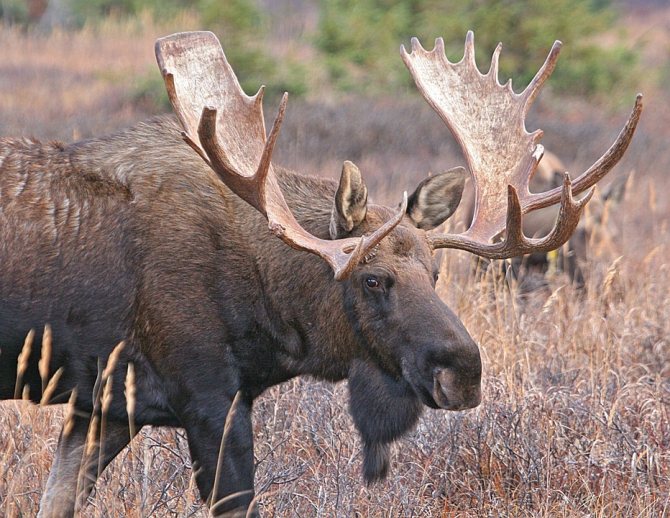
Photo: Pixabay.com
An elk in the forest will not be the first to attack. The exception is when a person comes too close to its habitat. If a moose pins its ears back and lowers its head, this is a signal that it is ready to attack. With a blow from its hoof, it can cause fatal injury to a person.
— Take a long stick in your hands and hold it in a vertical position. It will scare off moose because these animals are wary of objects that are taller than them. By the way, be careful when traveling on country roads by car. The dimensions of the car and the dimensions of an adult moose are approximately the same. When moose go out onto the road, they often do not perceive cars as a source of danger and can be hit, warns Aleksandrov.


